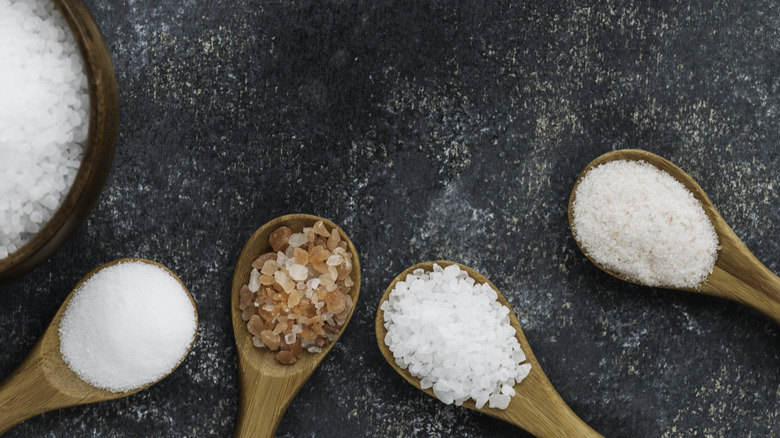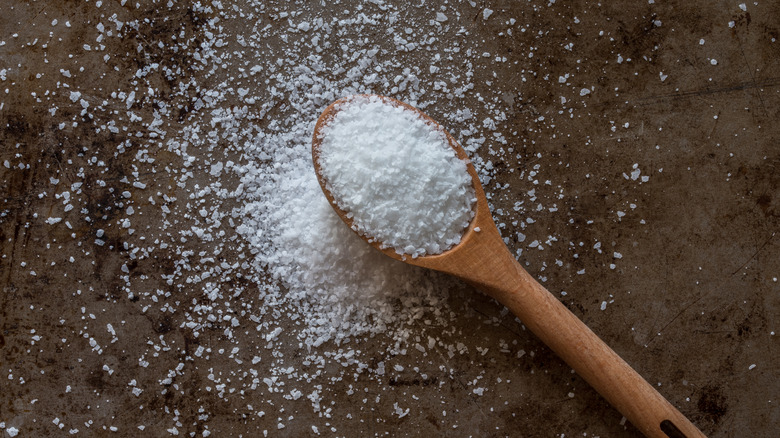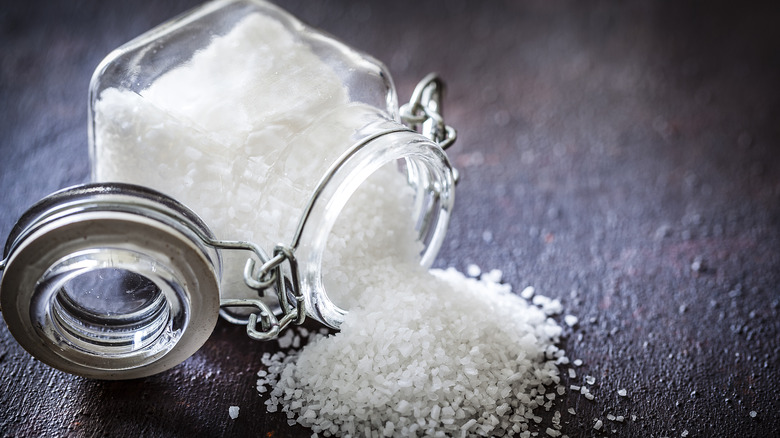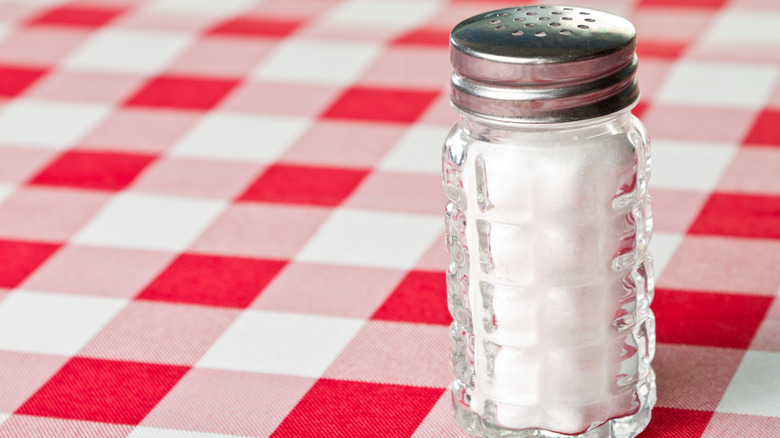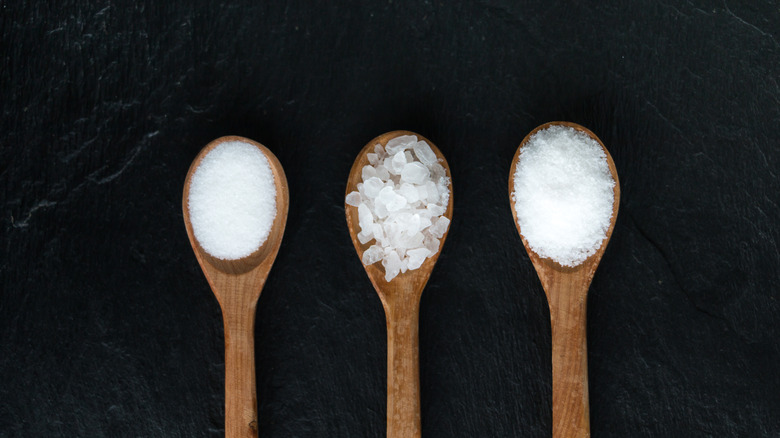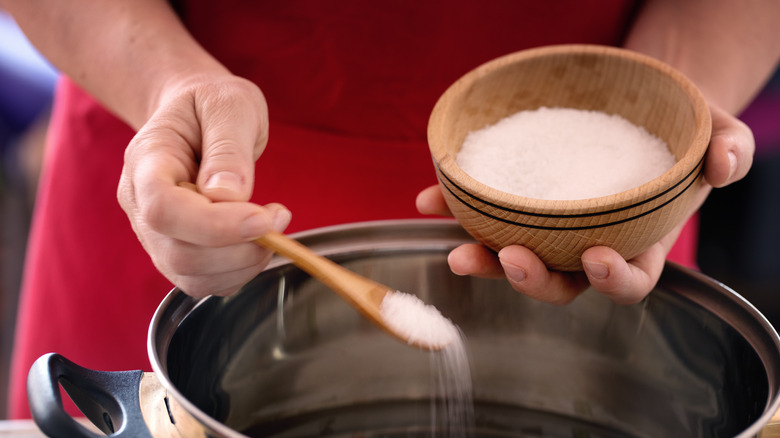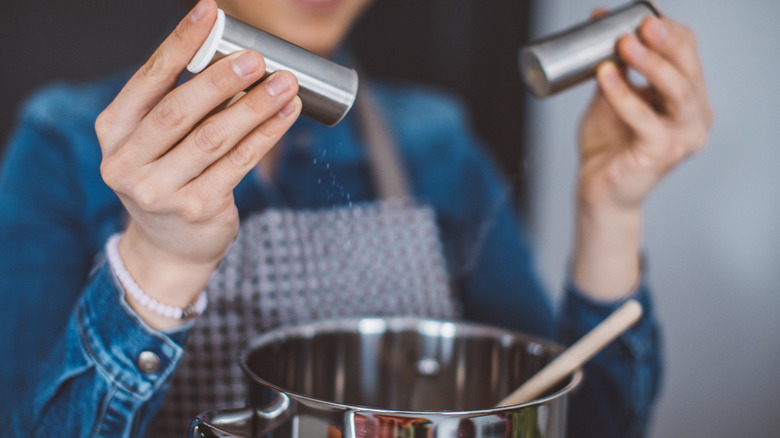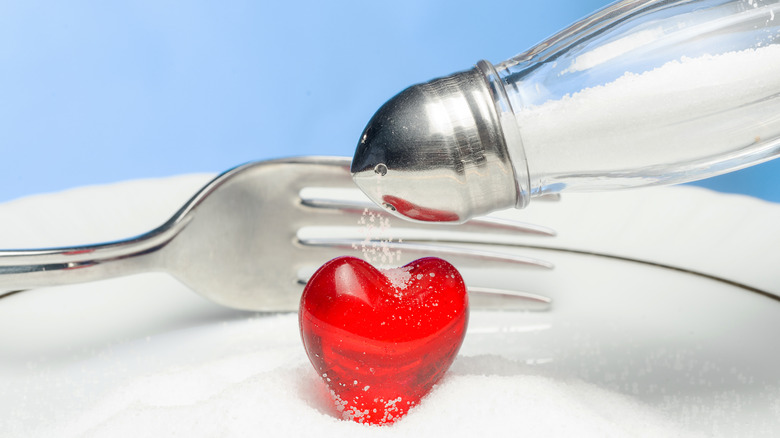The Difference Between Kosher, Table & Sea Salt
Inexpensive, versatile, and easy to use, salt is one of those ingredients that most of us don't give a second thought to. We use it to enliven bland soups, prevent pasta from sticking together, and improve the texture of meat. Given its central role in our kitchens, it makes sense to learn more about it, if only to avoid committing a baking faux pas.
For starters, there are three main varieties of salt: kosher, sea, and table. All three varieties are made up primarily of sodium (Na) and chloride (Cl), but the amount of each element differs from salt to salt. What's more, certain varieties contain naturally-occurring trace minerals, while others feature additives like iodine and sodium aluminosilicate, an anti-caking agent. In addition to chemical variations, salts differ in flavor, texture, and appearance. In this article, you'll learn even more about each of these three types of salt. You'll also get clarity on when to use each type and learn the necessary conversions. At the very end, you'll get the answer to the burning question on everyone's mind — which type of salt is the healthiest?
What is kosher salt?
Kosher salt is a coarse-grained salt that has flakes larger than those found in sea salt and table salt. Combined, these two properties make kosher salt a favorite among home and restaurant chefs alike. It's coarseness and relatively large size make it easy to grab without fear of oversalting your vegetables or meat. Chefs also appreciate the fact that kosher salt is essentially pure sodium chloride. The lack of additives means it's one of the purest-tasting salts available.
Although its name suggests otherwise, kosher salt has little to do with Jewish tradition, at least in its modern iteration. Historically, this type of salt was used in the process of koshering meats. The salt's large crystals are well-suited to the process because they easily adhere to the meat and draw out the liquids. Besides that, kosher salt doesn't season meat too much, meaning it's difficult to oversalt proteins during the process. While pretty much every home cook will appreciate the benefits of kosher salt, it's important to look for kosher-certified salt if you're following a kosher diet.
What is sea salt?
Technically speaking, all salt comes from salt water. That said, kosher and table salt are mined from the salt deposits of evaporated bodies of seawater, whereas sea salt comes from bodies of water still in existence. Sea salt is obtained by removing water through solar or vacuum evaporation, at least in practice. In the United States, the Food and Drug Administration pays more attention to the purity of sea salt than its provenance. To put it another way, salt can be labeled as sea salt as long as it's free of additives, regardless of where it comes from.
Although it's minimally processed and free of additives like iodine and anti-caking agents, sea salt is rich in natural minerals such as magnesium, iron, calcium, and potassium. These minerals add flavor and color to the salt but not much else. In other words, you won't get much of a nutrition boost from consuming sea salt. You're much better off getting your daily dose from other food sources. When it comes to texture, sea salt is softer than kosher salt but coarser than table salt. Its crystals tend to look like pebbles or small pyramids. Speaking of crystals, the size of sea salt crystals falls somewhere in the middle between kosher salt and table salt.
What is table salt?
As its name suggests, table salt is the variety you're likely to see when you sit down for a meal. Of all of the varieties of salt, table salt has the finest texture and the densest structure. Because its crystals are smaller, more salt fits into each teaspoon, making it saltier than other varieties. That means you don't need much to notice the difference in flavor, so use it sparingly.
Something else worth noting about table salt is that it often contains iodine. This trace element has been added to table salt since the 1920s. At that time, many were suffering from thyroid issues and goiters due to a lack of iodine. To address the issue, salt companies started iodizing their products. While simple, this strategy proved surprisingly effective. These days, iodine deficiency isn't much of a concern in the United States. However, you're still likely to find iodized salt at the grocery store. There's nothing wrong with it, but it tends to have a slightly metallic taste. To prevent wacky flavors, we recommend looking for the non-iodized version.
The main differences between kosher, sea, and table salt
There are quite a few differences between kosher, sea, and table salt. For starters, they don't resemble each other much. Kosher salt is coarse and has an uneven grain. Some crystals are flake-like, while others are more pyramidal in shape. Sea salt is also coarse (albeit less so than kosher salt), but its crystals are more regularly-shaped. Table salt has a tight, even grain, giving it a more powdery appearance than the other two types.
Chemically speaking, all three types of salt are made up primarily of sodium chloride. That said, there are some major differences in each salt's composition. Out of the three, kosher salt is arguably the purest form. In fact, the United States Department of Agriculture requires kosher salt to be at least 97.5% sodium chloride. Table salt also contains that much sodium chloride, but a lot of table salt contains iodine, an ingredient that impacts taste and purity. For its part, sea salt contains trace minerals like magnesium, iron, calcium, and potassium. The presence of these minerals means that the percentage of sodium chloride in sea salt may dip as low as 90% in some varieties.
Aside from visual and chemical differences, these three forms of salt differ in terms of their provenance. Kosher and table salt are sourced from underground salt deposits resulting from ocean and sea evaporation. In contrast, sea salt comes from the evaporation of salt water still in existence.
When to use kosher, sea, and table salt
Whenever you're cooking and have a doubt about which kind of salt to use, reach for the kosher variety. Kosher salt can be used before, during, or after cooking. For instance, you can use it to season pasta water or when smoking meat. You can even use it on the rim of your margarita glass to create an interesting flavor contrast. Baking is pretty much the only occasion where you should avoid using kosher salt. The large crystals don't get evenly distributed, leading to some bites that are saltier than others.
Sea salt is appropriate for seasoning pasta water and meat before cooking. It's also an excellent addition to homemade dressings, marinades, doughs, and batters. Gourmet sea salts like Maldon and Fleur de Sel are pricey and should only be used for finishing dishes like steaks and chocolate chip cookies.
Table salt is well suited for adding flavor to soups, rice dishes, and casseroles after cooking. Because of its relatively neutral flavor and fine texture, you can also use it to season pasta water. It works just fine in doughs and batters, especially those that call for a small quantity of salt (less than two teaspoons). With that in mind, it's best to cook with non-iodized table salt to avoid adding any metallic flavor to your prized dishes.
Can you substitute one for another?
Kosher salt is the gold standard when it comes to cooking, but if you don't have any on hand, you can substitute sea salt or table salt in its place. With its large grains and complex flavor, course sea salt is the next best option. Thankfully, the conversion is pretty straightforward. Use one teaspoon, of course, sea salt for every 1 ¼ teaspoon of kosher salt a recipe calls for.
While sea salt is the ideal kosher salt substitute, you can use table salt in a pinch (pun intended). Bearing that in mind, it's important to use non-iodized table salt. The iodized variety tastes like metal, which could take your recipe from yummy to yuck in seconds. It's also essential to pay attention to the conversions when using table salt. Thanks to its fine grains, table salt packs quite a bit more saltiness into each teaspoon compared to sea or kosher salt. For every teaspoon of kosher salt, use ¾ of a teaspoon of table salt.
What salt is healthiest?
Whether you're watching your sodium intake because of an existing health condition or just out of a desire to live your best life, you might be wondering which type of salt is the healthiest. We hate to say it, but no one type of salt is inherently healthier than another. Sure, some varieties like pink Himalayan salt market themselves as healthy options because of the trace minerals they contain. However, the reality is that these minerals are present in such small amounts that they won't make much of a difference in your overall health. That's not to say they're not worth using, just that you shouldn't expect much when substituting one type of salt for another.
What really matters when thinking about the connection between salt and health is the quantity you use. According to the Food and Drug Administration, adults should consume no more than 2,300 milligrams of sodium per day. That works out to approximately one teaspoon of table salt. Most of us consume far more than that on a regular basis, so if you're truly concerned about improving your health, your best bet is to prioritize eating whole foods as much as possible. You can also reduce your sodium intake by looking for no or low-sodium substitutes and flavoring foods with spices instead of salt.
